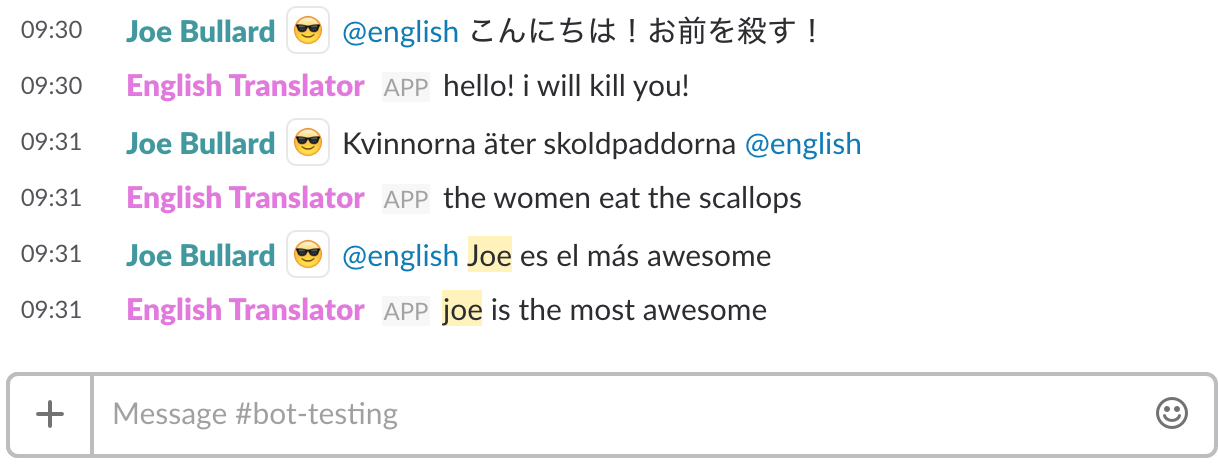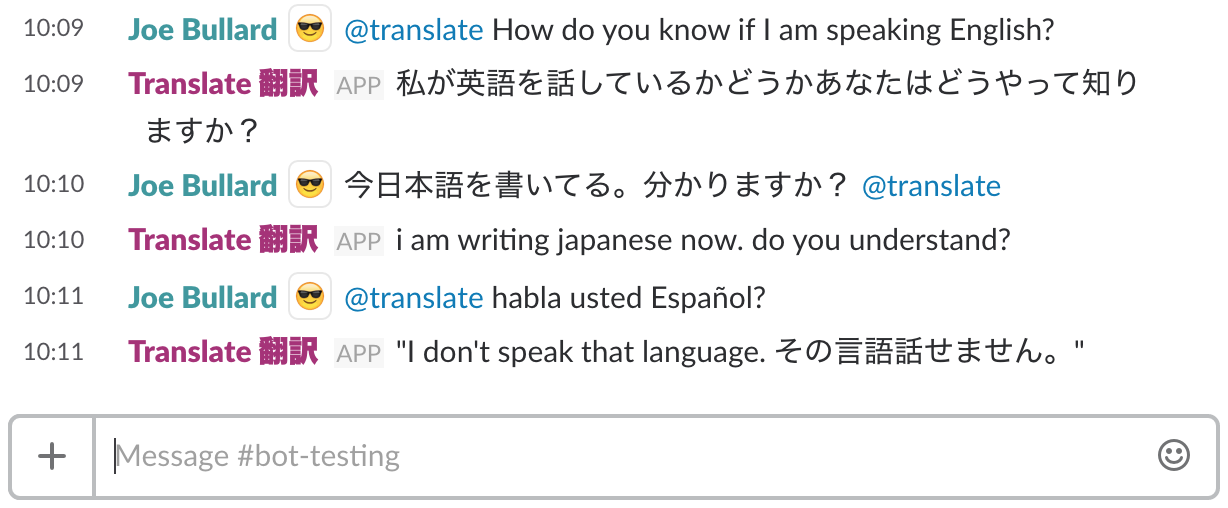This part of the repo provides and implementation of a Slackbot which can perform either one-to-one translation (e.g. Japanese <-> English), or many-to-one translation (e.g. anything -> English).
The target language of the bot (along with some other variables) is set in the environment, rather than the code or a static file, to make it easier to deploy multiple bots with different languages.
Example of a many-to-one translation bot for English:
Example of a bilingual one-to-one translation bot for Japanese and English:
First, create a bot user for your team and configure the name, description, photo, etc as you wish. See the Slack Bot Documentation if you do not know how to do this. You will need the token on this page to run your bot.
The bot depends on a few environment variables:
BOT_TOKEN: (required) Slack bot token obtained when creating the bot userTARGET_LANG: (required) official 2-letter code for the target languageSOURCE_LANG: (optional) official 2-letter code for the source language. Defining this variable will result in a one-to-one translation bot, not defining it will result in a many-to-one translation bot.GOOGLE_CREDENTIALS: (optional) path to GCP credentials JSON file (e.g. service account). If deploying in Google Cloud, you don't need to supply this unless you have specific requirements for it. When running locally, failing to supply this mean you are using the public-facing Translate API and will be cut off after a small number of requests.GREETING: (optional) greeting message to display when the bot joins a channelAPOLOGY: (optional) apology message to display when the bot encounters an errorILLITERATE: (optional) message to display when a one-to-one bot is asked to translate a language it does not speak
Save these values in typical bash syntax inside of a file
(see .sample-env.one2one and .sample-env.many2one in this repo).
The env values we defined are obtained through the dotenv package when
running directly in node:
node -r dotenv/config index.js dotenv_config_path=my-env-file
You don't have to run the bot in Docker, but there are some nice benefits of doing so.
You can build the Docker image in the root of this repo like this:
docker build -t slack-translate-bot .
It is best practice to never include sensitive data like credentials or API
keys inside of a Docker image.
The .dockerignore supplied in this repo will ignore a credentials/
directory, which is where you can place your Google service account JSON.
Since the env file you created specifies a path to a credentials JSON,
you must mount the directory as a volume in your Docker container, so it can
be found at runtime (that means you may need to alter your GOOGLE_CREDENTIALS
variable to match your desired path inside the container);
e.g.:
docker run -d \
--name bot-en
--env-file my-env-file
-v $(pwd)/credentials/:/credentials
slack-translate-bot
Assuming I set GOOGLE_CREDENTIALS=/credentials/credentials.json and I have a
file ./credentials/credentials.json, then the container ran in the command
above should have no trouble.
Note that if you are reploying this in Google Container Engine (GKE), then you don't even need to specify or provide credentials at all, as the defaults will automatically be used.
If you still want to use a specific service account, then you should probably supply it as a Kubernetes secret.
TODO: add instructions for GKE deployment

